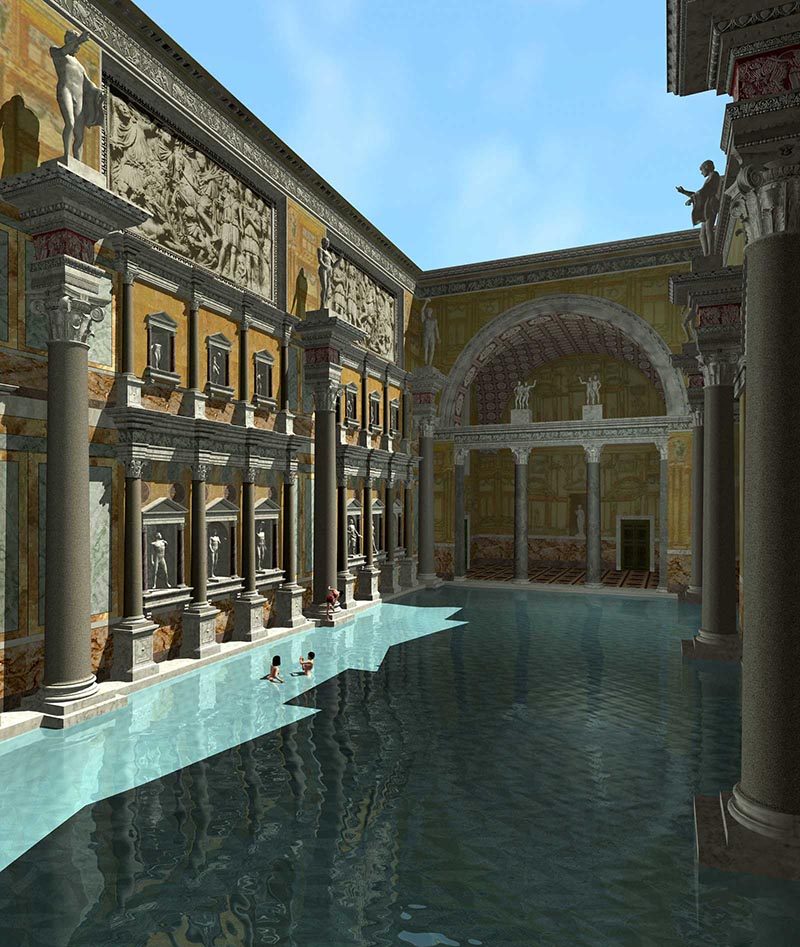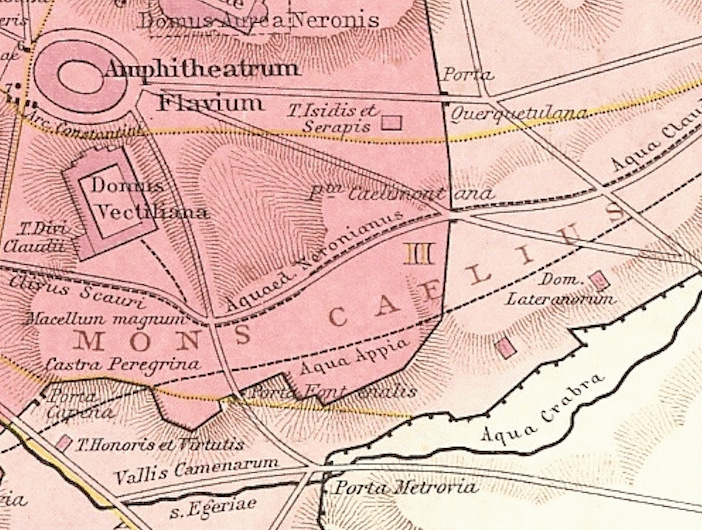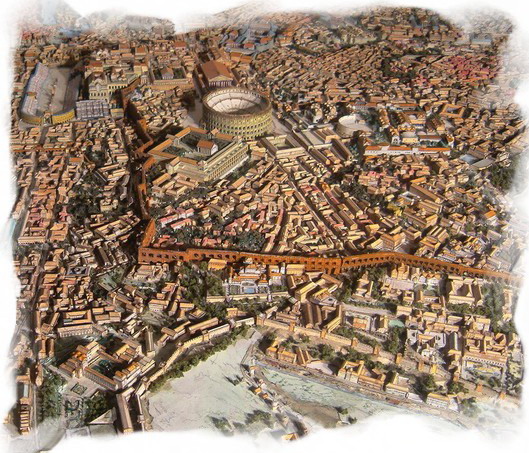By the end of this journey, you will have learned Perseus found and bested the Gorgon Medusa. Along the way, we’ll review the Perfect Active System and its three tenses — the Perfect, the Pluperfect, and Future Perfect.
A. Let’s start by re-reading the first three chapters of our exciting fābula dē Perseō and adding the next installment Dē Gorgōnis capite (“The Gorgon’s Head”). As we continue to review, some elements of the previous versions of the story will be tweaked for elegance (and to add the new grammar that we are reviewing).
Multī fābulās dē Perseō nārrant. Perseus fīlius erat Iovis, maximī deōrum; avus Perseī est Ācrisius. Sed Ācrisius volēbat Perseum nepōtem suum necāre; nam propter ōrāculum puerum timēbat. Comprehendit igitur Perseum adhūc īnfantem, et cum mātre in arcā ligneā inclūsit. Tum arcam ipsam in mare mīsit. Danaē, Perseī māter, magnopere timēbat; tempestās enim magna mare turbābat. Perseus autem in gremiō mātris dormiēbat.
Iuppiter tamen haec omnia vīdit, et fīlium suum servāre cōnstituit. Tranquillum igitur fēcit mare, et arcam ad īnsulam Serīphum perdūxit. Hūius īnsulae Polydectēs tum rēx erat. Postquam mare tranquillum arcam ligneam cum fīliō Iovis ad lītus mōverat, Danaē in harēnā pācem capiēbat. Post breve tempus piscātor mātrem et infantem invēnit, et duōs ad domum rēgis Polydectis dūxit. Ille mātrem et puerum benignē excēpit, et iīs sēdem tūtam in fīnibus suīs dedit. Danaē hoc dōnum libenter accēpit, et prō tantō beneficiō rēgī grātiās ēgit.
Perseus igitur multōs annōs ibi habitābat, et cum mātre suā vītam beātam agēbat. At Polydectēs Danaēn magnopere amābat, atque atque matrem Perseī in mātrimōnium dūcere volēbat. Polydectis cōnsilium tamen Perseō minimē grātum erat. Polydectēs igitur Perseum dīmittere cōnstituit. Tum iuvenem ad sē vocāvit et haec dīxit: “Turpe est ignāvam vītam agere; iam dūdum tū adulēscēns es. Quō usque hīc manēbis? Tempus est arma capere et virtūtem praestāre. Hinc abī, et caput Medūsae mihi refer.”
[incipit fābula dē Gorgōnis capite]
Perseus ubi haec audīvit, ex īnsulā discessit, et postquam ad terram vēnit, Medūsam quaesīvit. Diū frūstrā quaerēbat; namque nātūram locī ignōrābat. Tandem Apollō et Minerva viam dēmōnstrāvērunt. Prīmum ad Graeās, sorōrēs Medūsae, pervēnit. Ab hīs tālāria et galeam magicam accēpit. Apollō autem et Minerva falcem et speculum dedērunt. Tum postquam tālāria pedibus induit, in āera ascendit. Diū per āera volābat; tandem tamen ad eum locum vēnit ubi Medūsā cum cēterīs Gorgōnibus habitābat. Gorgōnēs autem mōnstra erant formā horribilī; Anguēs enim capita Gorgōnum omnīnō contēxerant. Aenī etiam erant manūs Gorgōnum.
difficillimum erat caput Gorgonis abscīdere; Gorgonis enim forma hominēs in saxum vertēbat. Propter causam Minerva speculum Perseō dederat. Ille igitur tergum vertit, et in speculum īnspiciēbat; hōc modō ad locum vēnit ubi Medūsa dormiēbat. Tum falce suā caput Medūsae ūnā plāgā abscīdit. Clāmor cēterās Gorgōnum statim ē somnō excitāvērunt, et ubi rem vīdērunt, īra magna omnēs commōvit. Arma rapuērunt, et Perseum occīdere volēbant. Ille autem dum fūgit, galeam magicam induit; et ubi hoc fēcit, statim ē oculīs Gorgōnum ēvāsit!
B. Always read and re-read until you have a good sense of the story.
Complete this short comprehension exercise in Cerego. If you any of the aspects of the fābula eluded you, be sure to return and re-read the story and try again!
C. Now, let’s continue our tour of basic Latin morphology with the most regular of Latin tenses: the Perfect Tense, Indicative Mood, Active Voice.
You can find more about the Perfect Tense in Allen & Greenough §161 (tenses of the finite verb), §473 (perfect definite and historical infinitive), §475 (special uses of the perfect)
D. Are you ready to tackle the Perfect Active Indicative?
Before you practice your verb forms, take a few minutes to solidify your knowledge of the basic contours and terminology of Perfect Indicative Active verbs with this short comprehension activity.
E. Let’s practice Perfect Indicative Active.
1. Practice the paradigms of the Perfect Indicative Active on Magistrula.com.
✮ Practice these paradigms on Magistrula.com, write them out again and again on a sheet of paper, muttering to yourself as you exercise, or in any way that works for you until you are completely and totally confident in your ability to reproduce the paradigm for the Perfect Indicative Active of any (regular) verb.
If you seek more practice, you can visit linguaclassica.com.
2. Practice Identifying Perfect Indicative Active of regular and “irregular” verbs on Magistrula.com until you feel very confident that you can accurately translate any basic perfect indicative active verb that comes your way.
F. Do we need to spend any time looking at the perfect active system of irregular verbs?
If you think yes, then review the video on the Perfect above.
If you understand why we don’t need to worry ourselves about irregular perfects, good job! You’ve earned a rest on the steps of the Temple of the Deified Claudius!

After the Emperor Claudius died in 54 CE, the senate ordered that he be worshipped as a god. His fourth wife, Agrippina the Younger, began building a magnificent temple. This temple was damaged in the Great Fire of 64 and further compromised by Claudius’ adopted son, the Emperor Nero, who demolished parts of the temple during the construction of the Aqua Claudia aqueduct and his palace, the Domus Aurea. When Nero was assassinated and the Domus Aurea destroyed, Nero’s successor, Vespasian, restored the temple.
G. Now, let’s move further into the past by reviewing the Pluperfect Tense, Indicative Mood, Active Voice.
1. Invest 4 minutes reviewing the Pluperfect Active.
You can find more about the Pluperfect Tense in Allen & Greenough §477 (pluperfect)
2. Practice the paradigms of the Pluperfect Indicative Active on Magistrula.com.
H. Now, let’s go back to the future by reviewing the Future Perfect Tense, Indicative Mood, Active Voice.
1. Invest 4 minutes reviewing the Future Perfect Active.
You can find more about the Future Perfect Tense in Allen & Greenough §478 (future perfect)
2. Check your knowledge of the Pluperfect and Future Perfect Active Indicatives by completing this short comprehension exercise in Cerego.
3. Practice the paradigms of the Future Perfect Indicative Active on Magistrula.com.
I. Practice Identifying Perfect, Pluperfect, and Future Perfect Active verbs on Magistrula.com until you feel very confident that you can accurately translate any basic perfect active system verb that comes your way.
J. Nicely done! Contemplate your achievements while gazing down at the Colosseum.

The Colosseum was built in only 8 years (72-80 CE) by the three emperors of the Flavian dynasty. The largest amphitheater ever built, the Colosseum could hold as many as 85,000 spectators, who delighted in gladiatorial contests, animal hunts, executions, re-enactments of famous battles and (the gorier) myths.
K. Practice of all perfect system verbs in the story on Quizlet. You’ll be asked the tense for most verbs and, in some instances, for the person and number of the verb.
L. Re-read the new chapter of our fābula with special attention to Verbs of the Perfect Active Systems.
Perseus ubi haec audīvit, ex īnsulā discessit, et postquam ad terram vēnit, Medūsam quaesīvit. Diū frūstrā quaerēbat; namque nātūram locī ignōrābat. Tandem Apollō et Minerva viam dēmōnstrāvērunt. Prīmum ad Graeās, sorōrēs Medūsae, pervēnit. Ab hīs tālāria et galeam magicam accēpit. Apollō autem et Minerva falcem et speculum dedērunt. Tum postquam tālāria pedibus induit, in āera ascendit. Diū per āera volābat; tandem tamen ad eum locum vēnit ubi Medūsā cum cēterīs Gorgōnibus habitābat. Gorgōnēs autem mōnstra erant formā horribilī; Anguēs enim capita Gorgōnum omnīnō contēxerant. Aenī etiam erant manūs Gorgōnum.
difficillimum erat caput Gorgonis abscīdere; Gorgonis enim forma hominēs in saxum vertēbat. Propter causam Minerva speculum Perseō dederat. Ille igitur tergum vertit, et in speculum īnspiciēbat; hōc modō ad locum vēnit ubi Medūsa dormiēbat. Tum falce suā caput Medūsae ūnā plāgā abscīdit. Clāmor cēterās Gorgōnum statim ē somnō excitāvērunt, et ubi rem vīdērunt, īra magna omnēs commōvit. Arma rapuērunt, et Perseum occīdere volēbant. Ille autem dum fūgit, galeam magicam induit; et ubi hoc fēcit, statim ē oculīs Gorgōnum ēvāsit!
M. Nicely done! Take a break from the midday heat by visiting the elegant frescos beneath the Church of Saints John and Paul.

This fresco, which dates from the 3rd century CE, depicts Proserpina and cherubs in a boat. Originally decorating a Nymphaeum, this and adjoining buildings became a site of Cristian worship. In the final years of the 4th century CE, the senator Pammachius built a church over the site in honor of the two Roman soldiers, John and Paul, who were martyred under the emperor Julian in 362.
N. Rested, re-read the our fābula with special attention to Active Verbs of the Present and Perfect Active Systems.
Multī fābulās dē Perseō nārrant. Perseus fīlius erat Danaēs et Iovis, maximī deōrum; avus Perseī est Ācrisius. Sed Ācrisius vult Perseum nepōtem suum necāre; nam propter ōrāculum puerum timēbat. Comprehendit igitur Perseum adhūc īnfantem, et cum mātre in arcā ligneā inclūsit. Tum arcam ligneam in mare mittit. Danaē, Perseī māter, magnopere timēbat; tempestās enim magna mare turbābat. Perseus autem in gremiō mātris dormiēbat.
Iuppiter tamen, pater deōrum, omnia crūdēlia vidēbat, et fīlium suum servāre cōnstituit. Tranquillum igitur facit mare, et arcam ad īnsulam Serīphum māgnā cum celeritāte perdūcit. Polydectēs tum rēx erat īnsulae Serīphī. Postquam mare tranquillum arcam ligneam cum fīliō Iovis ad lītus mōverat, Danaē in harēnā pācem capiēbat. Post breve tempus piscator mātrem et infantem invenit, et duōs ad domum rēgis Polydectis dūcit. Polydectēs mātrem et infantem benignē excipit, et iīs domum tūtam in fīnibus suīs dat. Danaē dōnum rēgis Polydectis accipit hilaris, et prō tantō beneficiō rēgī grātiās agit.
Perseus igitur multōs annōs ibi habitābat, et cum mātre suā vītam beātam agēbat. At Polydectēs Danaēn magnopere amābat, atque matrem Perseī in mātrimōnium dūcere volēbat. Polydectis cōnsilium tamen Perseō minimē grātum erat. Polydectēs igitur Perseum dīmittere cōnstituit. Tum iuvenem ad sē vocat et haec dīcit: “Turpe est ignāvam vītam agere; iam dūdum tū adulēscēns es. Quō usque hīc manēbis? Tempus est arma capere et virtūtem praestāre. Hinc abī, et caput Medūsae mihi refer.”
O. Nicely done! Wash the dust of your feet in the gigantic Baths of Caracalla.

These baths were built in the early 3rd century during the reigns of emperors Septimius Severus and Caracalla. The second largest baths in the city, the towering Baths of Caracalla influenced the original Pennsylvania Station (New York) and Chicago’s Union Station.
P. One final round of review, now for all verbs of the Present and Perfect Active Systems on Magistrula.com. Review until you feel very confident that you can accurately translate any regular present or perfect active system verb that comes your way.
Z. Once you have successfully completed these activities, congratulations! You have taken the next step on your (re)exploration of Latin — and Rome — by Scaling the Caelian Hill.
Summary of Activities on the Perfect Active System
Cerego: [Reading Comprehension] [Perfect Indicative Active Comprehension] [Pluperfect and Future Active Indicatives Comprehension]
Latintutorial.com: [The Perfect Tense] [The Pluperfect Tense] [The Future Perfect Tense]
Lingua classica: [Latin Verb Drill]
Magistrula: [Perfect Indicative Active Paradigms] [Identifying Perfect Indicative Active forms] [Pluperfect Indicative Active Paradigms] [Future Perfect Indicative Active Paradigms] [Identifying Perfect, Pluperfect, and Future Perfect Active forms] [Identifying Present and Perfect Active System forms]
Other Resources and Practice on the Perfect Active System
Verb conjugation practice: [Latīnē Disce] [Latināta] [Lingua Classica]
More about Latin tenses


